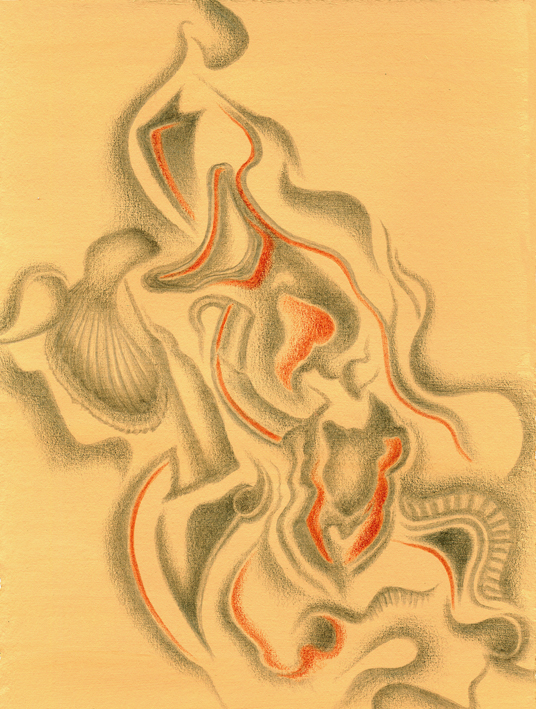How do I, as an artist, select “the longest threads” to represent the whole, complex tapestry of a piece of the natural world? Perhaps the only way I have found is to draw from life and learn, learn and learn some more of how nature is organised,
Read Moretree bark
Burgundy Drawings /
Ammonites de Bourgogne, silverpoint, watercolour, Jeannine Cook
It is done – I have managed to produce 15 drawings for the exhibition at the Musée de Noyers! What a relief! I deliver them next Monday and the exhibition will run concurrently with the show I have hanging at the gallery at La Porte Peinte.
Preparing for an exhibition under deadlines is never a favourite occupation for any artist. However, some people do work best like that. I am not sure that I do – the results of the effort will be for others to judge!
What has been both interesting but also more complex has been the need to weave together a body of work that pertains to the ideas I put forward originally, namely the birth of metalpoint drawing in the scriptora of monasteries, where monks used lead to delineate the illuminations and trace lines for the script of their illuminated manuscripts. Combined with that history, I wanted to celebrate the tiny fossilized oyster shells found in the Kimmelridgian layers of soil found especially in the Chablis area and which contribute to the special terroir of those wines. I had picked up samples of these heavy stones when I first arrived in Burgundy last year, and they have led me on a fascinating odyssey.
Tying the metalpoint’s history together with the fossil-laden stones was thanks to those industrious monks who in medieval times also helped to spread the cultivation of wine, as they founded the great monasteries in Burgundy. Vezelay, Fontenay, Pontigny: they are all centers of such a rich heritage.
Even the wonderful and mighty plane trees, such as one sees at Fontenay that was planted in 1780 by the Cistercian monks, ten years before they had to leave their monastery, was part of that long-standing monastic heritage that enriches us all.
The other aspect that I tried to incorporate into these drawings is the close links between Burgundy and ocre, one of the key pigments in man’s artistic endeavours since the earliest marks man-made on cave walls from Australia to Africa to Europe. Burgundy was famous for its yellow ocre deposits and only ceased to produce ocre pigments in the 20th century. By heating yellow ocre, red ocre is produced; the two pigments find their way into every drawing and painting imaginable down the ages. I used the two colours as tinted grounds for some of the drawings I did for this project. Since early times, some artists used tinted grounds for their metalpoint drawings, so again, I was following a long-standing tradition.
I loved finding out all sorts of things about history and aspects of beautiful Burgundy for this project. It has been such fun - the drawings have been the perfect vehicle and excuse for all sorts of new insights and investigations. It is marvellous when art and fresh knowledge can go hand in hand.
Keeping Eyes Fresh /
I must have walked the sandy lanes of our neighbourhood thousands of times in the past years. I know the area well enough to feel comfortable walking in the dark, knowing which protruding roots to avoid in the road, where the overhanging branches almost touch one's head.
Yet I am constantly amazed and delighted at how different the familiar scenes look each time I venture forth. Yes, the light and temperature change, depending on the weather and the season. Yes, the seasons bring forth different stages of vegetation and thus variations in colours of leaves, subtle changes in the marsh grasses. But there is something else that happens.
If each of us sets forth, consciously with eyes open and aware of surroundings, a walk yields wonderful rewards. An artist, especially, needs to keep eyes fresh and alert. You never know what will suddenly hit you as being special, worthy of exploration as an ingredient in art-making. No matter how well you know your surroundings, they can suddenly appear in a totally different way, given a willingness to look. Perhaps it depends too on one's frame of mind, what is happening subconsciously in terms of art...
This past week, I was rewarded with a whole new, exciting series of subjects to draw. Trees which I love and know well began to "talk" to me, not as I usually see them in terms of mighty, elegant structures with green canopies far above. My eyes were riveted to their barks, the ways this outer casing rippled and cracked, swirled and split, peeled and shredded. Every tree is different, even within the same type of tree. And one side of the tree is different, in many cases, from the other side of the same tree trunk. Totally fascinating.
Live Oak Bark
Live Oak Bark
Oak Tree Bark
These are just three examples of the bark of the wondrous Live Oak (Quercus virginiana).
Needless to say, my walks have been slowed down a great deal, as I use my fresh eyes to explore these new terrains!










